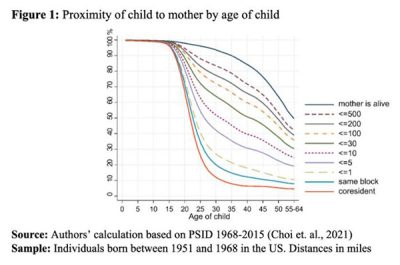Finding
Spatial proximity among family members may profoundly affect people’s lives. What are the salient features of family dynamics over geographic distance? HwaJung Choi, Robert Schoeni, Hongwei Xu, Adriana Reyes, and Deena Thomas provide the first national estimates of intergenerational proximity over the life course in the United States and discuss dynamic patterns and racial differences.

In a recent paper, we examine data spanning nearly half a century for people born 1951–1968 and provide valuable insights into the life course patterns of spatial availability of mothers (Choi et al., 2021). Figure 1 illustrates the life-course patterns indicating that nearly 90% of the sample persons at age 35 and about three quarters at age 45 had a living mother. The share of children living with or very close (within 5 miles) to their mother declines rapidly in the late teens and early twenties, as children leave their parental home seeking independence, education, and jobs. However, more than half still lived within five miles of their mother at age 25 and about 30% at age 40.
Read the article in the IUSSP’s online magazine, “How close to your mother? Lifetime dynamics and racial differences”
Choi, H., Schoeni, R., Xu, H., Reyes, A., & Thomas, D. (2021). Proximity to mother over the life course in the United States: Overall patterns and racial differences. Demographic Research, 45(23), 769–806. https://doi.org/10.4054/DemRes.2021.45.23
